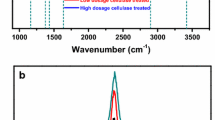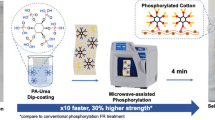Abstract
In this paper the effect of cutinase on the degradation of cotton seed coat is analyzed. Fourier transform infrared (FT-IR) microspectroscopy was applied to study the changes of chemical compositions in cotton seed coat epidermal layer and gas chromatography/mass spectrometry (GC/MS) was used to analyse cutinase depolymerization of cotton seed coat. Based on these arguments the ability of cutinase to degrade aliphatic components in cotton seed coat was verified. Positive effect of cutinase on degradation of cotton seed coat was observed with the combination of alkaline pectinase or xylanase. The removal of aliphatic components by cutinase enables other enzymes to penetrate into the inner of cotton seed coat. Cutinase can potentially improve the degradation of cotton seed coat during cotton fabric bio-scouring process.
Similar content being viewed by others
References
Csiszár, E., G. Szakács, and I. Rusznák (1998) Combining traditional cotton scouring with cellulase enzymatic treatment. Text. Res. J. 68:163–167.
Csiszár, E., A. Losonczi, and G. Szakács (2001) Enzymes and chelating agent in cotton pretreatment. J. Biotechnol. 89: 271–279.
Csiszár, E., K. Urbánszki, and G. Szakács (2001) Biotreatment of desized cotton fabric by commercial cellulase and xylanase enzymes. J. Mol. Catal. B: Enzym 11: 1065–1072.
Csiszár, E., A. Losonczi, B. Koczka, G. Szakacs, and A. Pomlenyi (2006) Degradation of lignin-containing materials by xylanase in biopreparation of cotton. Biotechnol. Lett. 28: 749–753.
Csiszár, E., G. Szakács, and B. Koczka (2007) Biopreparation of cotton fabric with enzymes produced by solid-state fermentation. Enzyme Microb. Technol. 40:1765–1771.
Fryxell, P. A. (1963) Morphology of the base of seed hairs of Gossypium I: gross morphology. Bot. Gaz. 124: 196–199.
Kolattukudy, P. E. (1980) Biopolyester membranes of plants: Cutin and suberin. Science 208: 990–1000.
Himmelsbach, D. S., D. E. Akin, J. Kim, and Ian Hardin (2003) Chemical structural investigation of the cotton fiber base and associated seed coat: Fourier-transform infrared mapping and histochemistry. Text. Res. J. 73: 281–288.
Gevens, A. and R. L. Nicholson (2000) Cutin composition: a subtle role for fungal cutinase? Physiol. Mol. Plant Pathol. 57: 43–45.
Degani, O., S. Gepstein, and C. G. Dosoretz (2002) Potential use of cutinase in enzymatic scouring of cotton fiber cuticle. Appl. Biochem. Biotechnol. 102–103: 277–289.
Agrawal, P. B., V. A. Nierstrasz, B. G. Klug-Santner, G. M. Gübitz, H. B. M. Lenting, and M. M. C. G. Warmoeskerken (2007) Wax removal for accelerated cotton scouring with alkaline pectinase. Biotechnol. J. 2: 306–315.
Agrawal, P. B., V. A. Nierstrasz, and M. M. C. G. Warmoeskerken (2008) Role of mechanical action in lowtemperature cotton scouring with F. solani pisi cutinase and pectate lyase. Enzyme Microb. Technol. 42:473–482.
Silva, C. M., F. Carneiro, A. O’Neill, L. P. Fonseca, J. S. M. Cabral, G. Guebitz, and A. Cavaco-Paulo (2005) Cutinase-a new tool for biomodification of synthetic fibres. J. Polym. Sci. A: Polym. Chem. 43: 2448–2450.
Araújo, R., C. Silva, A. O’Neill, N. Micaelo, G. Guebitz, C. M. Soares, M. Casal, and A. Cavaco-Paulo (2007) Tailoring cutinase activity towards polyethylene terephthalate and polyamide 6,6 fibers. J. Biotechnol. 128: 849–857.
Ryser, U. and P. J. Holloway (1985) Ultrastructure and chemistry of soluble and polymeric lipids in cell walls from seed coats and fibers of Gossypium species. Planta 163: 151–163.
Du, G. C., S. L. Zhang, Z. Z. Hua, Y. Zhu, and J. Chen (2007) Enhanced cutinase production with the thermobifida fusca by two-stage pH control strategy. Biotechnol. J. 2: 365–369.
Zhuge, B., G. C. Du, W. Shen, J. Zhuge, and J. Chen (2007) Efficient secretory expression of an alkaline pectate lyase gene from Bacillus subtilis in E. coli and the purification and characterization of the protein. Biotechnol. Lett. 29: 405–410.
Bailey, M. J. and K. M. H. Nevalainen (1981) Induction, isolation, and testing of stable Trichoderrna reesei mutants with improved pro-duction of solubilizing cellulase. Enzyme Microb. Technol. 3: 153–157.
Bailey, M. J., P. Biely, and K. Poutanen (1992) Interlaboratory testing of methods for assay of xylanase activity. J. Biotechnol. 23: 257–270.
Brühlmann, F., K. S. Kim, W. Zimmerman, and A. Fiechter (1994) Pectinolytic enzymes from actinomycetes for the degumming of ramie bast fibers. Appl. Environ. Microbiol. 60: 2107–2112.
Calado, C. R. C., S. M. S Monteiro, J. M. S. Cabral, and L. P. Fonsecal (2002) Effect of pre-fermentation on the production of cutinase by a recombinant Saccharomyces cerevisiae. J. Biosci. Bioeng. 93: 354–359.
Walton, T. J. and P. E. Kolattukudy (1972) Determination of the structures of cutin monomers by a novel depolymerization procedure and combined gas chromatography and mass spectrometry. Biochem. 11: 1885–1896.
Miller, G. L. (1959) Use of dinitrosalicylic acid reagent for determination of reducing sugars. Anal. Chem. 31: 426–428.
Villena, J. F., E. DomÍnguez, and A. Heredia (2000) Monitoring biopolymers present in plant cuticles by FTIR spectroscopy. J. Plant Physiol. 156: 419–422.
Yatsu, L. Y., K. E. Espelie, and P. E. Kolattukudy (1983) Ultrastructural and chemical evidence that cell wall of green cotton fibers is suberized. Plant Physiol. 73: 521–524.
Kačuráková, M., P. Capek, V. Sasinkováet, V. Wellner, and A. Ebringerová (2000) FT-IR study of plant cell wall model compounds: pectic polysaccharides and hemicelluloses. Carbohydr. Polym. 43: 195–203.
Wang, Q., X. Fan, W. Gao, and J. Chen (2006) Characterization of bioscoured cotton fabrics using FT-IR ATR spectroscopy and microscopy techniques. Carbohydr. Res. 341: 2170–2175.
Chung, C., M. Lee, and E. K. Choe (2004) Characterization of cotton fabric scouring by FT-IR ATR spectroscopy. Carbohydr. Polym. 58: 417–420.
Sene, C. F. B., M. C. McCann, R. H. Wilson, and R. Grinter (1994) Fourier-transform raman and fouriertransform infrared spectroscopy (an investigation of five higher plant cell walls and their components). Plant Physiol. 106: 1623–1631.
Author information
Authors and Affiliations
Corresponding authors
Rights and permissions
About this article
Cite this article
Yan, H., Hua, Z., Qian, G. et al. Effect of cutinase on the degradation of cotton seed coat in bio-scouring. Biotechnol Bioproc E 14, 354–360 (2009). https://doi.org/10.1007/s12257-008-0200-7
Received:
Accepted:
Published:
Issue Date:
DOI: https://doi.org/10.1007/s12257-008-0200-7




